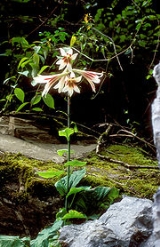
Cardiocrinum
Encyclopedia
Cardiocrinum is a genus of three or four species of bulbous plants of the family Liliaceae
. They are native to the Himalaya, montane China
, and Japan
. The bulbs are usually formed at the soil surface. The preferred habitat is woodland. The plants tend to be monocarpic
, dying after flowering.
They are closely related to Lilium
and are generally called by the common name giant lily. They differ from Lilium in some characteristics, most notably in the heart shaped leaves (hence the name, from the Greek kardio for heart, and krinum for lily).
The Himalayan species Cardiocrinum giganteum is the largest of any of the lily plants, growing up to 3.5 metres high.
Liliaceae
The Liliaceae, or the lily family, is a family of monocotyledons in the order Liliales. Plants in this family have linear leaves, mostly with parallel veins but with several having net venation , and flower arranged in threes. Several have bulbs, while others have rhizomes...
. They are native to the Himalaya, montane China
China
Chinese civilization may refer to:* China for more general discussion of the country.* Chinese culture* Greater China, the transnational community of ethnic Chinese.* History of China* Sinosphere, the area historically affected by Chinese culture...
, and Japan
Japan
Japan is an island nation in East Asia. Located in the Pacific Ocean, it lies to the east of the Sea of Japan, China, North Korea, South Korea and Russia, stretching from the Sea of Okhotsk in the north to the East China Sea and Taiwan in the south...
. The bulbs are usually formed at the soil surface. The preferred habitat is woodland. The plants tend to be monocarpic
Monocarpic
Monocarpic plants are those that flower, set seeds and then die. Other terms with the same meaning are hapaxanth and semelparous. The term was first used by Alphonse de Candolle....
, dying after flowering.
They are closely related to Lilium
Lilium
Lilium is a genus of herbaceous flowering plants growing from bulbs. Most species are native to the temperate northern hemisphere, though the range extends into the northern subtropics...
and are generally called by the common name giant lily. They differ from Lilium in some characteristics, most notably in the heart shaped leaves (hence the name, from the Greek kardio for heart, and krinum for lily).
The Himalayan species Cardiocrinum giganteum is the largest of any of the lily plants, growing up to 3.5 metres high.

